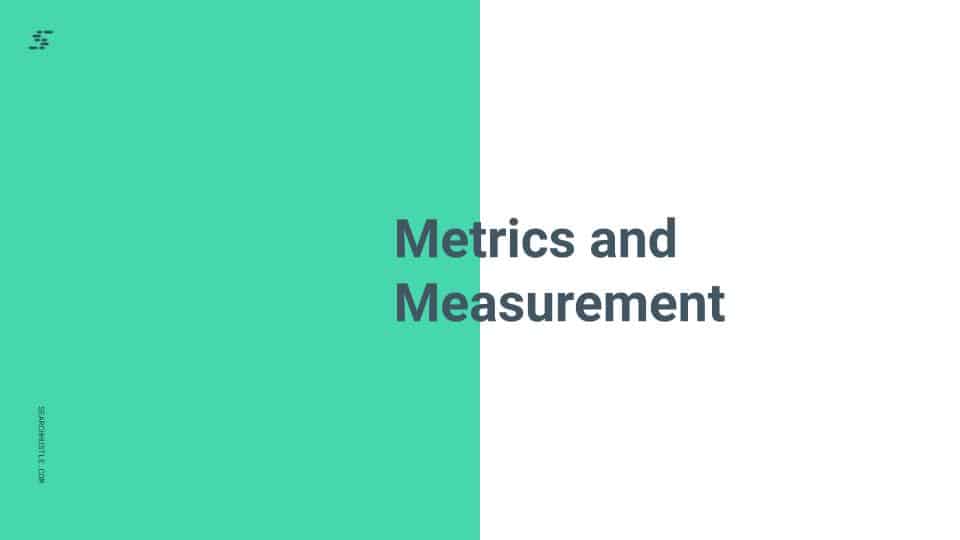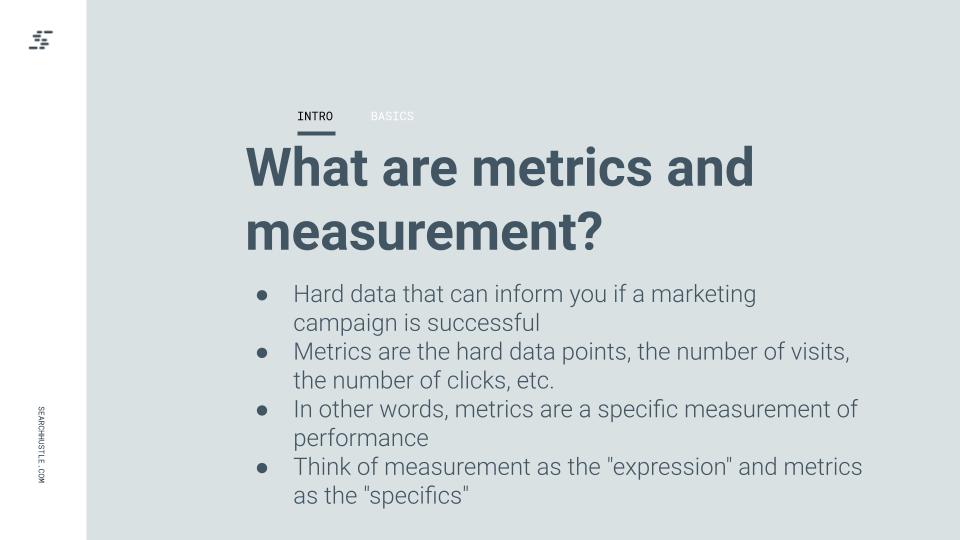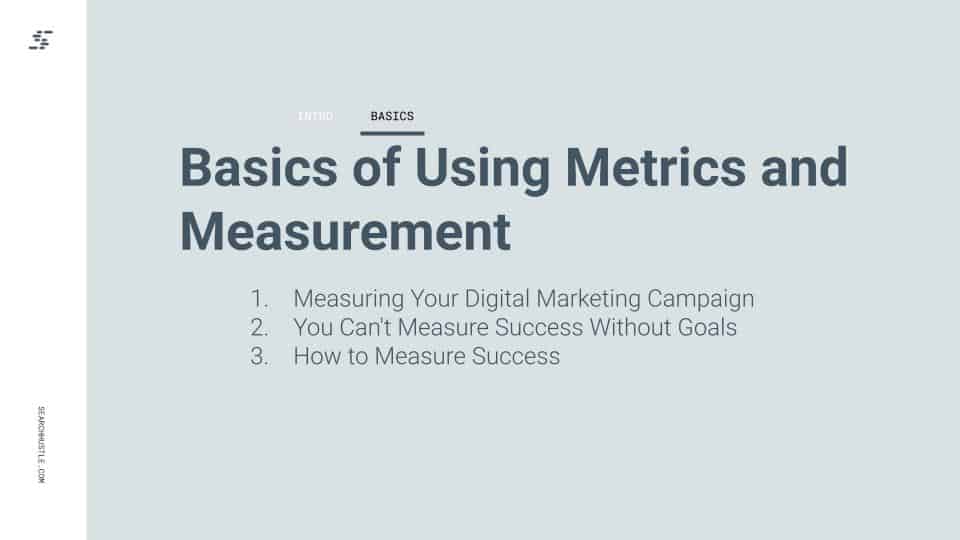Metrics and Measurement
Learn how to use metrics and measurements to make your website more effective with Search Hustle.

The only hard data that will tell whether or not a marketing campaign is being successful are the metrics we have access to. Metrics are the hard data points, the number of visits, the number of clicks, bounce rate, conversions, etc. They are a specific measurement of performance. So in this way you can think of measurement as the expression, and metrics as the specifics.
This is to say that metrics and measurement go hand in hand, one being data and the other being the context of what that data is doing for us. It is not enough to just know the data. Success can’t be judged by data. It has to be measured in terms of what that data means for a marketing campaign, digital footprint, and the bottomline.

Measuring Your Digital Marketing Campaign
In order to fully grasp the impact of your marketing campaign, you have to look at the metrics that it generates. These elements are often called conversions, such as leads from web forms, leads from outreach, live chats, phone calls, signups, etc. It is vital to understand what these metrics are doing so that you can measure the progress of your strategy.
It is also important to know what was being achieved before the campaign. What was happening before the marketing campaign started acts as a baseline from which a better understanding can be gleaned.
You Can't Measure Success Without Goals
None of this will make any sense without context. That is where strategic goals come into play. Set up your goals early and often, so that every measurement you take is directed towards figuring out your progress towards reaching those goals.
Goals must be set up so that the purpose of the marketing campaign is obvious, clear, SMART, and understandable to everyone involved. If goals aren’t set up, then you will be collecting metrics and measurements without a point. This would simply be a waste of time.

How do you Measure Success?
Metrics and measurements come together to determine success. The strategy and goals of the campaign will dictate what measure you use. Traditionally, driving sales and leads are the only definitive way to measure success. In the end, the goals set for the marketing campaign will be what the metrics that are collected get judged against.
Here are some specific measures that can be judged by collected metrics that will show how much success the campaign is having.
Overall traffic
Simply put, overall traffic is the pure number of people visiting a website. This includes people from all sources, who are visiting for any reason. While your goal may be to increase overall traffic, having overall traffic alone doesn’t reveal whether or not a strategy is working. For that, we have to dig a bit deeper.
Traffic by source
One of the key ways to know if outreach is successful is to measure where traffic is coming from. This means people who are visiting from social media, outside links, search engine traffic, and other similar means. Tracking this specific metric gives vital information about what projects in the campaign are bearing fruit.
Measure the differences of the source before and after a marketing push. For instance, if a recent push has been made to expand social media content and marketing, it is possible to know quickly if it has made a difference. There should be more visits from social media, giving you a measure of how successful the effort has been.
Average session duration
This is a metric that reveals how long a potential customer spends on the website. The longer this is, the more engaged and interested the potential customer might be. Content is key for prolonging duration, as giving interesting, relevant topics to a customer will often convince them to read and check out other links on the site.
The longer a viewer is kept on the website out of interest or engagement, the more likely they will become a lead or a customer.
Pageviews
This will reveal what pages are being viewed the most, such as which pieces of content or which areas of a website are being looked at. Each part of a website is a page, those pages come together to make the website itself. Tracking the traffic to each of these pages will give a strong indicator of how the website is being used by potential customers.
Most visited pages
This metric shows you which page is the most popular and common. Of course, it is obvious that the landing page should be the most viewed, being around equal to the total viewers. For content, however, this will reveal which piece of content and what type of content is most popular.
Expanding on which page is most viewed is an excellent way of tailoring content to the user. If everyone is enjoying a certain element of the website, it will be revealed by which pages have the most visits, after the landing page.
Bounce rate
Bounce rate is not a positive indicator, in fact, it is a negative one (usually). This will show how many people leave the website without delving any deeper into the content there. Basically, if a person arrives at the website, does nothing, and simply leaves again, your bounce rate will increase. It is very common for some blog posts to have high bounce rates and that just indicates potential for additional jump of pages of content.
A good goal to have is to increase engagement and thus lower the bounce rate. The lower the bounce rate, the better and more engaging your website is to visitors. Those visitors are then more likely to become future customers.
Conversions
While having potential customers and leads visit the site is great, conversions are the goal. This is where a visitor goes from being a passive viewer and engages with part of the website. This can be content, turning a visitor into a lead, or purchasing, turning a lead into a customer.
This makes the metric of conversions a key measure of success. No matter what other goals a marketing campaign has, increasing the number of conversions must always be among them.
Impressions
Impressions show how often an ad or piece of content has been rendered on a viewer’s screen. This is a very important metric if one of the goals of the marketing campaign is spreading brand awareness, as it should be. The more impressions, the more reach and impact your advertising or content is having on potential customers.
For large CPM campaigns, this metric is a key measure of success. If the goal is to simply reach and connect with as many thousands of people as possible, impressions are how you can judge impact.
Social engagement (clicks, shares, likes, retweets, comments)
To have an ever-expanding social engagement is a goal of many companies and businesses. Everything that is posted is tracked by the social media site. Clicks indicate people expressing interest, or checking out your content. Shares are to social media as word of mouth is to brick and mortar. Retweeting is simply Twitter’s version of sharing.
Getting likes will often increase the spread of content because algorithms will detect this increase in likes, and make the content more widely available. The same is true of comments, the more user engagement, the more the algorithm will work for you and not against you.

Ready to Take Your Search Hustle Further?



